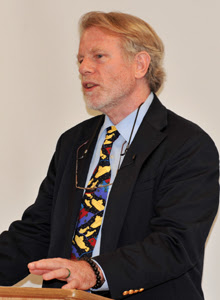Remembering John R. McRae

John R. McRae (28.04.1947 – 22.10.2011) was one of the most important US researchers in the area of Chinese Chan-Buddhism. After his studies of anthropology at Stanford University in California (B.A. 1969), McRae continued his education in the area of of 'Chinese studies' at Yale University in Conneticut (M.A. 1971).
After this he began his PhD under the guidance of Prof. Stanley Weinstein on the subject of the so-called 'North-School of the Early Chinese Chan'. On McRaes request for studying some time in Japan, Prof. Philip Yampolsky introduced him in Kyôto to the worldwide leading Chan-researcher Prof. Seizan Yanagida 聖山柳田 (1922-2006). Then McRae studied for many years in Kyôto in the seminars of Prof. Seizan Yanagida and Prof. Yoshitaka Iriya 義高入矢 (1910–1998). These studies were so ambitious and demanding, that the progress of his PhD-thesis could go on only slowly. But finally the hard acquired expert knowledge in these Kyôto-years made McRae's PhD-thesis (Yale, 1983) "The Northern School of Chinese Ch’an Buddhism" to such a fundamental work and today's standard about the history of the Early Chan-Buddhism. Subsequently this work was published in the book:
- John McRae, The Northern School and the Formation of Early Chan Buddhism (University of Hawai`i Press, 1986).
McRae published some important books and about 30 significant research papers, some thereof with his wife, the US-Buddhologist Prof. Jan Nattier (see also Bibliography Nattier, Publications Nattier). Alongside he did the following translations for the BDK Chinese Tripitaka Translation Project:
- Questions of Mañjuśrī (文殊師利問經 Taishō No. 468),
- The Vimalakīrti Sutra (維摩詰所說經 Taishō No. 475),
- The Śūrangama Samādhi Sutra (佛說首楞嚴三昧經 Taisho No. 642),
- Essentials of the Transmission of Mind (黄檗山斷際禪師傳心法要 Taishō No. 2012-A),
- The Platform Sutra of the Sixth Patriarch (六祖大師法寶壇經 Taishō No. 2008).
- Commentary on the Lotus Sutra (法華義疏 Taishō No. 2187).
For a complete summary about McRaes wide oevre and international activities see his Curriculum Vitae, date 10-02-2009. Among his numerous research papers the appreciation of the research of his venerated Japanese teacher Seizan Yanagida should be particularly mentioned:
McRae has dedicated his book about the history of Chinese Chan, published in 2003, to his teacher Seizan Yanagida. This book adresses a wide audience of Zen-practitioners and Zen interested persons and on the firm basis of a longtime research it brings much light (and 'enlightenment') into the development of the legends of the Chinese Chan-tradition. In his preface of "Seeing through ZEN" McRae writes:
"This volume is resolutely about Zen, not about how to practice Zen. It thus differs from the vast majority of books on Zen in English in that it does not assume the reader to be a potential Zen practitioner. Indeed, even the most dedicated practitioners will benefit by stepping outside their chosen tradition for the endeavor of its reading. I believe our roles as scholars and readers involve the active and critical imagination of the medieval evolution of Chinese Chan Buddhism. By active, I mean that we should constantly work to envision how Chan emerged in the medieval Chinese social and intellectual context; by critical, I mean that we should also work to consider all the available evidence from all possible angles, testing hypotheses and evaluating objections.
In many ways, my training in this process began with my graduate studies under Professor Stanley Weinstein, to whom I am dedicating my second research volume on eighth-century Chan Buddhism, provisionally entitled Zen Evangelist: Shenhui (684–758), Sudden Enlightenment, and the Southern School of Chinese Chan Buddhism (forthcoming from the University of Hawai‘i Press, under the auspices of the Kuroda Institute). The debt I owe Professor Weinstein, who has dedicated his career to the training of the finest cohort of scholars in American Buddhist studies, is incalculable.
The present volume is in effect my attempt to emulate the creative work of YANAGIDA Seizan 柳田聖山, with whom I had the privilege to study while writing my dissertation. As the greatest scholar of Chinese Chan Buddhism of the twentieth century, Professor Yanagida has brought to his writings both magisterial knowledge and profound sensitivity. Although my tutelage under Professor Yanagida came many years before this book was conceived, I have fond memories of sitting with him in his study, accepting bowls of delicious matcha tea, and discussing the contents of Chinese Chan texts. Even when I groped for ordinary Japanese vocabulary in our conversations, and even when I butchered the rules of classical Chinese grammar in our readings, his sympathetic patience was inexhaustible. (I will admit, however, that for the weekly seminars on Chinese Chan texts at Hanazono College, a Rinzai Zen institution, it would have been copacetic had the college marching band not chosen the very same time to practice its John Philip Sousa renditions!)
As the vanguard of a new wave of Japanese scholarship that revolutionized our understanding of Chan through analysis of handwritten manuscripts from the Dunhuang cave in Chinese Central Asia, Professor Yanagida has consistently demonstrated an interpretive brilliance that has energized an entire generation of Western students. If I have inherited even a small part of his legacy, I hope that the playful humanism of his example shines through these pages. I dedicate this book to Professor Yanagida with a depth of gratitude I can only hint at in words."
In the summer 2010, on a long-distance flight, McRae contracted a deep vein thrombosis and while staying in an Amsterdam clinic for treatment there happened accidentally the discovery of a pancreatic tumor. John's wife Jan Nattier reports about the months from John's diagnosis until his death in october 2011 in the following Blog.
The author of these lines bows low to John R. McRae und sincerely thanks his wife Mrs. Jan Nattier for the abandonment of John's CV.
M.B. Schiekel, Ulm, April 2015.

